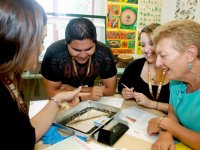Troubleshooting PBL
The perfect PBL experience is ever-changing, so be ready to ask questions, reflect, and revamp your approach while showing complete faith in your students’ abilities.
Your content has been saved!
Go to My Saved Content.Teachers know that no lesson plan is impeccable. The plan that led to profound discussion and whole-class engagement can later (even that same day!) fall flat, due to personalities, group dynamics, the time of day, or who knows what else. Yet teachers find ways to adapt, read the group, change their approach, and modify their plans in order to make lessons work in different contexts.
Checking the Temperature of the Room
There are a lot of misconceptions about project-based learning and how to best structure classes, units, and lessons within PBL environments. The good news is that there are many different PBL strategies that lead to success for students. The bad news, also known as reality, is that even the most thoughtful, carefully planned project can take a turn for the worse, requiring teachers to reflect and modify. PBL can reveal the profound nature of deep learning experiences, (check out Suzie Boss' posts for some great examples), but it can also expose what feels like an infinite number of ways for the learning to derail.
It's important for teachers to be observers, frequently checking what George Lakey taught me to think of as the temperature of the room. This means recognizing times when student engagement is lagging, when the work being produced is low quality, or when a project worked for some students but was not accessible to all. Rather than seeing these moments as failures, teachers can respond with reflection and action. These are the times when we learn and strengthen our practice.
When I feel frustrated with the project that I designed, with my students, or with the climate in my classroom, I step back to ask questions, reflect, and consider revamping my approach. These questions remind me of my goals and the potential for transformational school learning:
- Am I giving students opportunities to do work that matters?
- Do students have meaningful choices?
- Am I providing opportunities for students to be creative?
- Have I provided models for the work and clearly explained my expectations?
- Are larger projects chunked into pieces, and have students who missed checkpoints gotten the help that they need?
- Are students sharing work-in-process with the class in order to inspire others and help those who are struggling?
- Do students have access to quality resources that can push their ideas forward?
- Are students getting feedback from me and from their peers during the process?
- Can students' work be shared with a wider audience?
- Do students feel that their work is valued and celebrated?
A Classroom Example
Some of my students are beginning the process of creating education vision statements in the form of digital stories. They've already written about meaningful learning experiences, and together we read and discussed different ideas about schooling and unschooling. Next week I will set them loose. Here's that sequence of events:
- As a class, we will brainstorm questions for investigation.
- Students will research and create annotated bibliographies.
- I will share resources that I've collected, showing them sample digital stories.
- They will write scripts for their own stories and begin production.
- We will link each of the videos from a website that we'll build, and then share the final products widely.
Each of these steps will require extensive consultation, tinkering, and revision. There will without a doubt be conflicts, frustrations, and missteps. My plans will need to change, and I will surely encounter obstacles that I'm not anticipating. I'll persist and work to convey my faith in my students' abilities and their potential to produce high-quality products.
Despite the inevitable messiness of PBL, the project will succeed. Students will be doing work that matters to them, work that deserves to be out in the world. They will be motivated to share ideas and passions in creative ways, knowing that their voices will be heard.
P.S. Check out our collection of Education Vision Digital Stories.
What are your PBL troubleshooting strategies?
